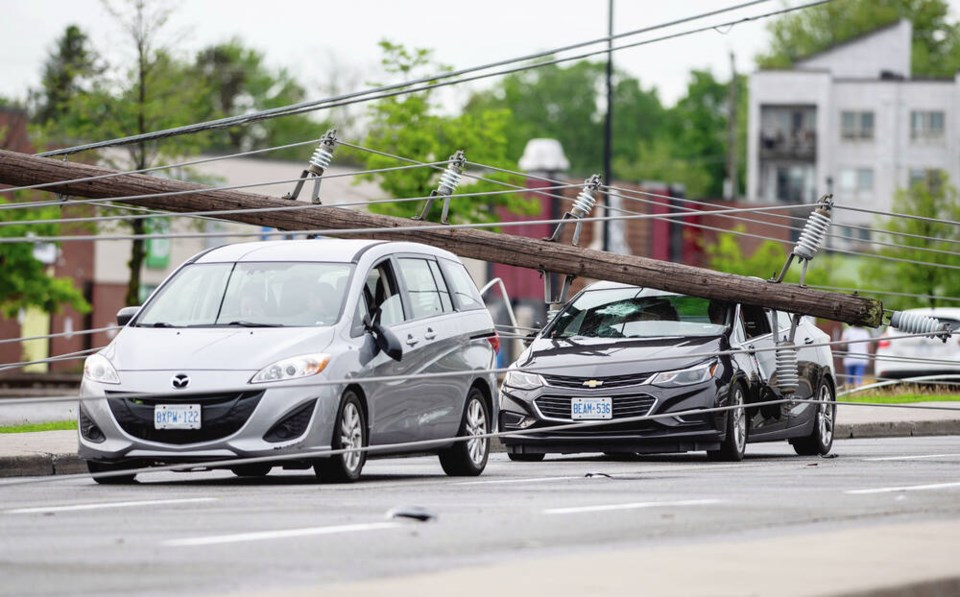Two items stood out for me last week during this year’s version of Snowmagedon — or as they call it in Winnipeg — a couple of balmy days.
The first was the tragic story of three people who died in Portland, Oregon, after snow laden branches broke off, bringing down high voltage power lines over top of their vehicle. Two people from the car died while trying to escape the vehicle, while a third was electrocuted to death trying to rescue them. Miraculously a 9-month-old infant survived the incident.
The second item is about cars sliding uncontrollably down snow and ice laden hills — their drivers totally at the mercy of gravity and physics.
It took me a long time to understand that downed power lines are not just coursing through your car with several hundred volts of electricity. The ground around your car is also very likely energized — and deadly.
In Portland, the man and woman actually managed to get out of their SUV safely, with their 9-month-old baby. Once outside though, the man slid backwards on the icy road surface and contacted the downed line.
The woman, who grabbed the man in an effort to save the baby, also came into contact with the power circuit. Both were electrocuted. The woman’s 15-year-old brother tried to rescue the three but was electrocuted himself when he made contact with the icy patch around the victims.
By some miracle the baby who lay on the man’s chest was not affected. An 18-year-old woman who witnessed the incident managed to grab the baby from the man’s chest and bring it to safety. Portland first responders were stunned that she wasn’t killed herself.
This incident shows us that high voltage electricity is unpredictable and often malevolent. Being prepared for an incident like this one is essential.
Never drive over downed power lines including times when lines might be tangled and hidden in the midst of a large branch on the road.
Stay in your vehicle if power lines come into contact with your vehicle. Assess your situation and call for help. If you don’t have a cellphone — it’s time to get one. You may be miles from help some day. Wait for first responders to arrive and obey their instructions.
The exception is when your vehicle is on fire or there is a greater threat to life occurring.
But you can’t just get out of your vehicle. Stepping out onto the road, while still touching your vehicle, completes the “ground” which electricity needs to complete a circuit — electrocution follows.
Officials agree that the proper way to exit here is to jump as far as you are able from the vehicle and land while keeping both feet together. Keeping feet together minimizes the voltage difference between two points of contact. It’s when there is a voltage difference between two points of contact, such as a normal walking step, that current flows — and current flow is deadly.
Once free from the vehicle keep your feet together while shuffling away from danger — never letting one foot go past the toes of the other. Move at least 10 metres, or 3 car lengths, away from your vehicle.
If you witness a crash with power lines, stay back, call for help, tell victims and others to stay put, keep them calm with verbal reassurance and keep the emergency operator informed.
Sliding down an icy hill is a sickening feeling. Like most driving safety issues, prevention is best. If it’s a snowy day and there’s a steep hill on your route, choose another way.
If you start sliding down a hill, you essentially have 3 options: bad, worse, even more worse.
One Hail Mary which might work — keep your wheels turning. Pushing harder and harder on the brakes won’t do anything. Allowing your wheels to turn gives you a small chance of gaining some traction, allowing for some steering.
If your rear end is sliding out, turn the steering in the direction you are skidding. If your front end is skidding, ease off of the brakes to allow the wheels to spin to regain traction. Steer gently in the direction you need to go.
Anti-lock brake systems today do most of this work for you by applying brake power while allowing your wheels to keep turning. It’s the chunk…chunk…chunk sound you have probably heard when braking hard.
It’s better to steer into a hedge than another vehicle. It’s better to steer into a vehicle than a person. Jumping out of your car is very dangerous. You’re better off buckled up and protected by the vehicle’s safety systems.
But remember there are really no great options here, except maybe staying home.



